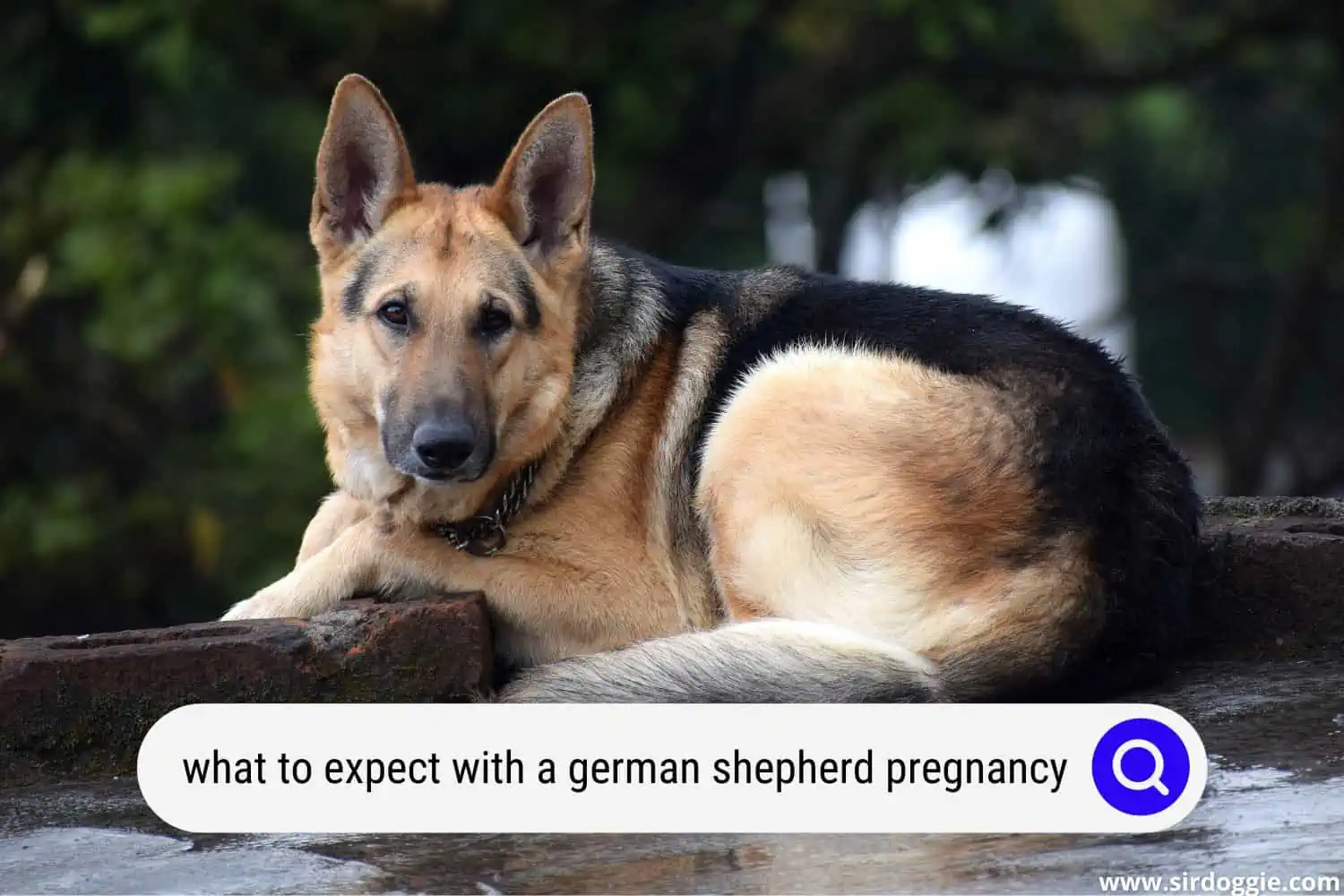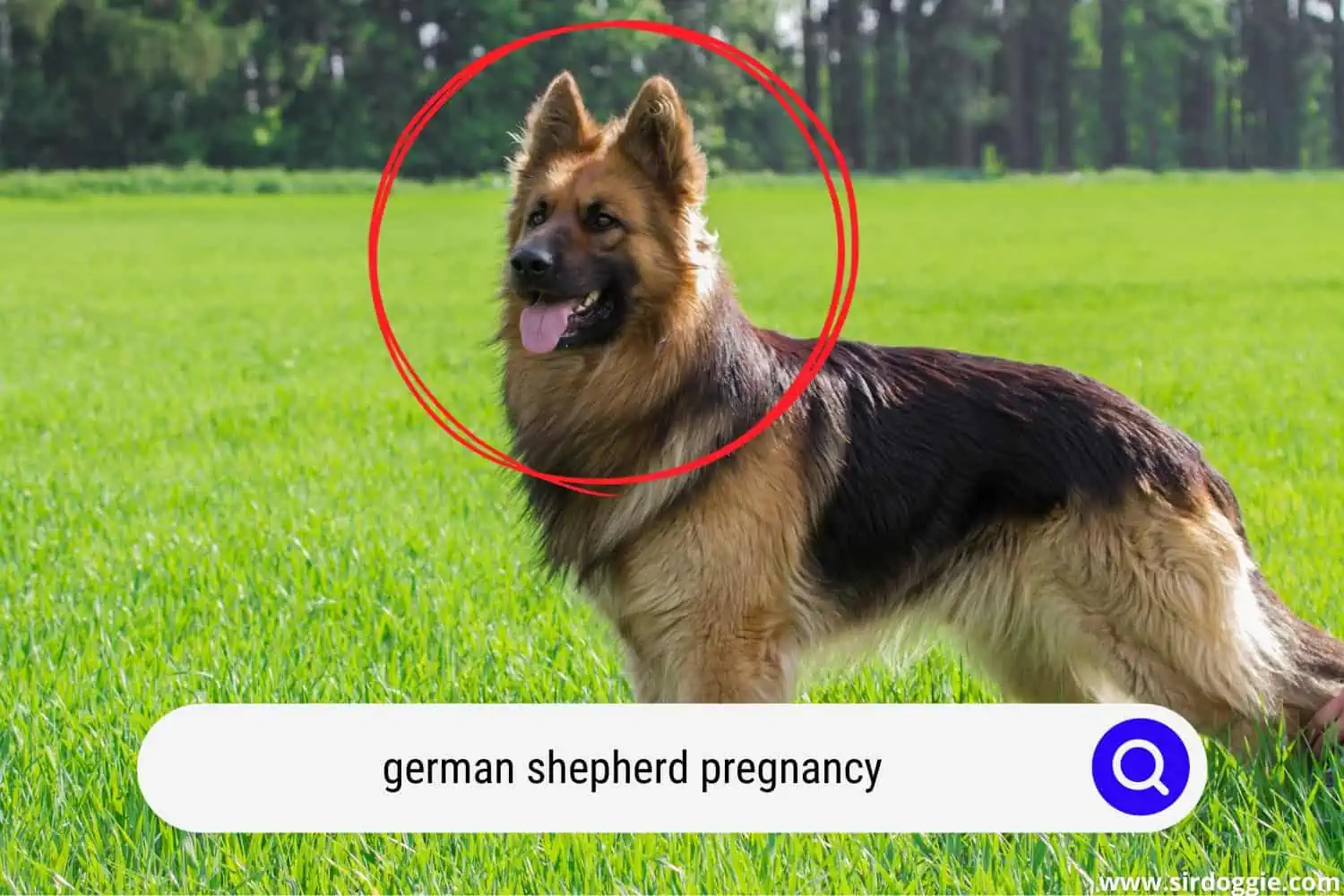What To Expect With A German Shepherd Pregnancy
German Shepherds, like other dog breeds, are pregnant for about 63 days. To understand the pregnancy of a dog, it is helpful to understand the female dog’s heat cycle which includes Proestrus, Estrus, Diestrus, and Anestrus.

Proestrus lasts for 9 days and is when the female begins to attract males. Estrus lasts for 3-4 days and is marked by a female dog and is available to a male dog. Diestrus is the final day of the reproductive cycle occurring around Day 14. The female will no longer permit mating during this time. Anestrus is the period between one heat cycle and the next and this is typically 6 months.
Generally, the dog’s pregnancy will last 58-72 days from the first time of breeding or 56-58 days from the first day of diestrus.
Related Reading: Are German Shepherds Hypoallergenic Dogs? [ANSWERED]
How Can You Tell if a Dog is Pregnant?
In the early days of a dog’s pregnancy, it can be hard to tell if she is pregnant. Some early signs to look for include:
- Fatigue
- Decreased Activity
- Change in Appetite.
- Unusual Behavior
- Enlarged Nipples
- Nesting Behaviors
- Weight Gain/Enlarged Abdomen
How Many Pups Will a German Shepherd Have?
Purebreds usually have fewer pups than mixed breeds. The largest German shepherd litter recorded was 17 live pups, but the usual German Shepherd litter is between 6-9 pups. One or more stillborn pups are not uncommon.
No one will deny that puppies are adorable, and German Shepherd puppies are among the cutest of them all.
If you are fortunate enough to witness puppies being born, you will see they come out as tiny, dark, wet little figures reminiscent of embryos. German shepherd pups are born looking like little walnuts.

Stages of a German Shepherd’s Life
A German Shepherd goes through several stages of life and each stage is marked by several important milestones. An owner should be aware of each stage so that he can provide the support and training needed for the stage.
1. Neonatal Stage
This is the helpless puppy stage. Characteristics of this stage are closed eyes, wet fur, and total dependence on the mother. This phase lasts up to ten days.
During this time an owner should provide supervision and proper nutrition to the mother dog, and monitor all the dogs to see if there are any immediate needs.
2. Transitional Stage
This is the stage between neonatal and socialization and is marked by the opening of the puppy’s eyes and with that, a curiosity about his surroundings.
This stage typically lasts about a week. The puppies will generally stay close to the mother and not wander off.
3. Socialization Stage
This stage begins at around 3 weeks old and is marked by a desire to socialize with both people and other animals.
This is an important stage because it is the window of time that should be used to socialize the puppy as his habits and manners are largely set here and these can last a lifetime.
This stage lasts for about 3 months and owners should provide the pups with plenty of opportunities for socialization.
4. Juvenile Stage
This stage takes place from 3-6 months and during this phase, your puppy will want to branch out and explore his surroundings much more.
This is also the phase where the pup needs good supervision as he can get himself into trouble very easily. This is the best stage to work on eliminating any aggression or anxiety.
5. Adolescent Stage
At around 5 months old your German Shepherd turns into an adolescent and is now sexually curious. This lasts until about 2 years old.
6. Adult German Shepherd Dog
At around 3 years old the German Shepherd becomes an adult. You can lessen the supervision by this stage as earlier training should have created a well-mannered and disciplined pet.
How to Care for Your Dog During Pregnancy?
During pregnancy, your German Shepherd will need good nutrition, exercise, and adult supervision in order to have the best chances of delivering healthy pups.
German Shepherd Signs of Labor
A dog in labor will generally appear agitated and will pace back and forth as it moves through the first and second stages of labor.
Provide your dog with a private space, either a kennel, box, or small room, and lay down blankets or newspapers as your dog will want to nest.
When the dog’s temperature drops to below 99 degrees, he will birth to pups within 24 hours of this temperature drop.
The German Shepherd
Did you know that 2 out of 3 households have a family pet and that the most popular pet of all is a dog? For sure, Americans love their canines whether they come from a shelter, a pet store, or a breeder.
Mutt or purebred, there is no denying the companionship, charm, and joy that a dog brings to a household. And one of the most popular dog breeds of all is the German Shepherd.
Traits and Characteristics of a German Shepherd
Temperament
It is not hard to understand the appeal of a German Shepherd. The American Kennel Club (AKC) calls the temperament of a German Shepherd “Confident, Courageous and Smart” and ranks it the number 2 most popular breed in the US, second only to the Labrador Retriever.
Physical Characteristics
The male German Shepherd, which is part of the Herding group of canines, grows to 24-26 inches high and the female to 22-24 inches high. Males weigh, on average, 65-90 lbs. and 50-70 lbs females.
The life expectancy of German Shepherds is 12-14 years but that can vary based on many factors.
History of the German Shepherd
German Shepherds were bred to herd sheep in, as you can guess Germany. They were trained to chase away predators on their family’s farm sometime around the 1850s.
The breed was selected for this role due to their intelligence, strength, and a keen sense of smell.
In 1919, the AKC registered 55 German Shepherds in its records, but by 1927 that number had grown to over 8,000. Today, in the US alone, there are nearly 80 million German Shepherds. This beloved breed is clearly here to stay, and for good reason.
Some Other Things to Consider About German Shepherds
German shepherds are popular for a reason. They are deeply loyal, obedient, and protective. But along with these admirable features are some that could be problematic for some.
They are highly sensitive, enjoy rough play, are very energetic, and can be very clingy. For these reasons, they are not the perfect dog for all families.
Only those adults who can give their German Shepherd proper exercise, rough play, training, and stimulation should consider this breed, as neglecting any one of these areas could result in a stubborn and untrainable, miserable dog.

Conclusion
So many Americans love dogs, and German Shepherds are among the most popular of all breeds. While German Shepherds are an adored breed, care should be taken to evaluate whether the dog is right for the situation.
They are extremely protective, energetic, and smart and this requires owners who can devote a great amount of time and dedication to training them.
Like all dogs, German Shepherds have a much shorter period of pregnancy than humans, generally around 63 days long. During pregnancy, the mother will exhibit several signs of pregnancy including a swollen abdomen, fatigue, a change in appetite, enlarged and discolored nipples, and weight gain.
Pure breeds, including German Shepherds, generally have fewer pups than mixed breeds, and still, births often occur in the breed. Caring owners will provide their gestating dog with a comfortable area in which to labor and nest and will monitor her to ensure she can deliver the pups without intervention.
Once a dog’s temperature drops to below 99 degrees, delivery of the pups will occur within 24 hours.

Family Dog Expert Author
Hi there! I’m Stuart, a devoted dog lover and family dog expert with over a decade of experience working with our furry companions. My passion for dogs drives me to share my knowledge and expertise, helping families build strong, loving bonds with their four-legged friends. When I’m not writing for SirDoggie, you’ll find me hiking, playing with my beautiful dog, or studying music.